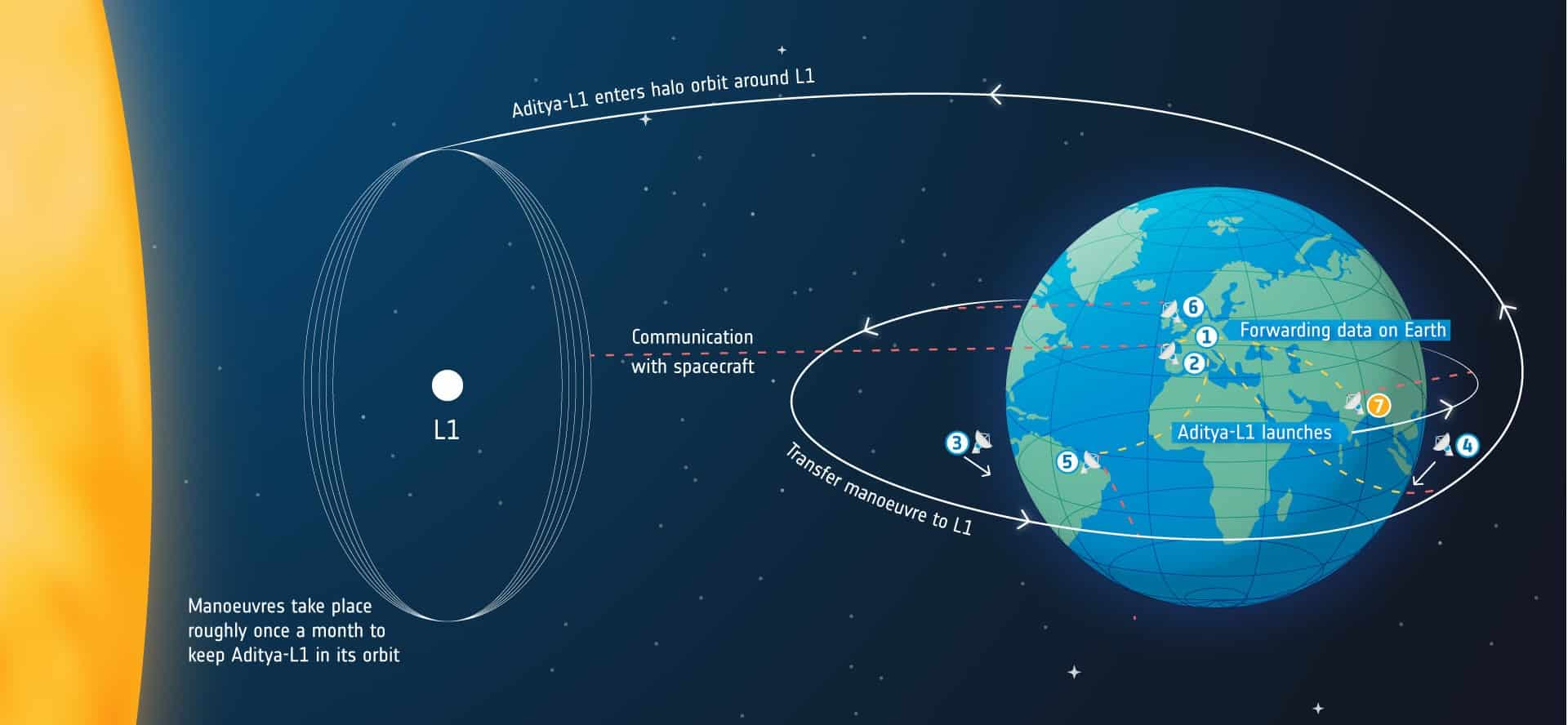In the vast expanse of the cosmos, where humanity’s thirst for exploration knows no bounds, recent developments in the world of space exploration have captured our attention. From India’s bold ventures into the heavens to SpaceX’s innovative Rover plans and the pressing need for upgrades to the Deep Space Network, there’s a lot happening beyond our planet’s atmosphere. In this comprehensive article, we’ll delve into these intriguing topics, shedding light on the latest space news.
India’s Soaring Ambitions: Aditya L1 Solar Observatory
India’s ISRO (Indian Space Research Organisation) has embarked on an exciting mission, setting its sights on the Sun itself. On September 1st, they launched the Aditya L1, a solar observatory designed to unravel the mysteries of the Sun’s Corona. This ambitious project follows closely on the heels of ISRO’s successful landing of the Chandrayaan III vehicle on the lunar South Pole.
Aditya L1’s Mission: A Glimpse Into the Sun’s Heart
Aditya L1’s primary mission is to observe the Sun from the vantage point of the L1 LaGrange Point, situated more than 1.5 million kilometers from Earth. This strategic location ensures that the observatory is never blocked by an eclipse, providing uninterrupted observations of the Sun’s activities.
But why study the Sun’s Corona specifically? The Corona, the outermost layer of the Sun’s atmosphere, presents a conundrum to scientists. While the Sun’s surface, called the Photosphere, is relatively cooler at around 6000 degrees Kelvin, the Corona boasts scorching temperatures of approximately 2 million degrees Kelvin. This extreme temperature difference, akin to a surface colder than the outermost layer of its plasma, has perplexed astronomers for years.
Aditya L1: A Crucial Piece of the Puzzle
Aditya L1’s mission is pivotal in understanding this coronal heating mystery. Solving this puzzle not only contributes to the field of heliophysics but also has practical implications, such as improving space weather forecasting to protect our technological infrastructure from solar flares and eruptions.
Moreover, India’s involvement in such complex missions signifies its growing stature in the global space exploration arena. ISRO is showcasing a thoughtful approach to tackling scientific enigmas while staying within its budgetary constraints.
Flexibility and Prudent Planning
India’s foray into space is marked by careful planning and setting achievable goals. Take, for instance, the Chandrayaan missions. Landing on the Moon’s South Pole is a formidable challenge, but ISRO undertook it systematically, with Chandrayaan III marking a significant achievement.
This calculated approach extends to other projects, like Aditya L1, where India is making valuable contributions to heliophysics while adhering to its means and capabilities. Instead of trying to “flex” its might, ISRO demonstrates prudence and ambition in equal measure.
SpaceX’s Flex Rover: A Lunar Game Changer
SpaceX, the pioneering private aerospace company led by Elon Musk, is making waves in the realm of space exploration. While much attention is on SpaceX’s plans for Mars colonization, another development has caught our eye: the Flex Rover.
Flex Rover: A Rover with a Twist
The Flex Rover, developed by Venturi Astrolab, is now officially partnered with SpaceX. This unique planetary mobility vehicle is designed to accommodate varying cargo loads by expanding and contracting, thanks to its flexible frame. It features a versatile arm that can be equipped with various tools and supports modular equipment, enabling customization for specific missions.
Key Features of the Flex Rover
Let’s take a closer look at some of the remarkable features of the Flex Rover:
| Feature | Description |
|---|---|
| Expandable Frame | The Flex Rover can adapt to different cargo sizes. |
| Flexible Arm | Equipped with a versatile arm for a range of tasks. |
| Modular Equipment | Interchangeable equipment for mission-specific needs. |
| Lithium-ion Batteries | Powered by efficient lithium-ion batteries. |
| Extendable Solar Panels | Side-mounted panels for extended operations. |
| Remote Operation | Can be operated remotely, enhancing mission flexibility. |
SpaceX’s Lunar Missions and the Flex Rover
SpaceX’s plans to use the Flex Rover on private missions involving their prototype Starship vehicle highlight its potential significance. The Rover can be stowed within the Starship’s cargo area and then deployed on the Moon, Mars, or other celestial bodies, expanding our capabilities for lunar exploration and beyond.
Implications for Future Exploration
The Flex Rover isn’t just a game changer for SpaceX; it has broader implications for space exploration. Venturi Astrolab’s innovative design and SpaceX’s endorsement could lead to its adoption in various missions, including those conducted by NASA. Imagine fleets of Flex Rovers preparing lunar or Martian terrain for human colonization, moving cargo, and aiding in construction—all before astronauts set foot on these celestial bodies.
The Deep Space Network’s Dilemma: Struggling to Keep Up
While space agencies and private companies embark on ambitious missions, there’s an essential backbone that often goes unnoticed—the Deep Space Network (DSN). This network of gigantic antennas, strategically positioned in California, Australia, and Spain, plays a crucial role in communicating with spacecraft beyond Earth’s immediate orbit.
The DSN’s Overwhelming Challenge
Recent missions, like Artemis I, have put the DSN to the test. During Artemis I, the DSN clocked 1774 hours of communication time, maintaining nearly constant contact with the Orion capsule and supporting CubeSats. This level of communication, while necessary, strained the network’s capabilities.
Budgetary Constraints and Expansion Plans
One of the root causes of the DSN’s struggles is budgetary constraints. Expanding and upgrading this vital communication infrastructure comes with a hefty price tag. The network’s limitations have been exacerbated by a lack of funding for improvements and expansion over the years.
The DSN’s Critical Role
The DSN serves as the lifeline for numerous missions, including the James Webb Space Telescope, Mars rovers like Perseverance, and far-reaching probes like Voyager and New Horizons. It is the medium through which crucial data is relayed back to Earth and mission commands are sent out.
Future Lunar Communication Challenges
The impending Artemis missions, with their lunar focus, pose additional challenges. As NASA plans to return humans to the Moon, the DSN’s ability to handle the increased communication demands will be put to the test. The risk of communication blackouts during critical lunar missions looms if upgrades are not implemented in time.
Expanding the Sis-Lunar Communications Network
NASA’s response to the DSN’s limitations includes the construction of six 18-meter antennas on the Moon’s surface. These lunar-based antennas are expected to be operational by 2027, providing support for future lunar missions.
A Balancing Act: Budget vs. Necessity
The DSN’s predicament underscores the complex balance between budgetary constraints and the necessity for robust communication infrastructure. As space exploration ventures become more ambitious, adequate support for critical infrastructure like the DSN is imperative to ensure the success and safety of missions.
Conclusion
In the ever-evolving landscape of space exploration, India’s ISRO continues to make strides with missions like Aditya L1, unraveling the mysteries of our Sun. SpaceX’s Flex Rover introduces innovative mobility solutions for lunar exploration, potentially reshaping how we approach planetary exploration. Meanwhile, the Deep Space Network faces the challenge of accommodating an increasing number of missions with limited resources.
As we peer into the cosmos, these developments remind us that space exploration is not just about reaching new frontiers; it’s also about overcoming logistical challenges, pushing the boundaries of technology, and, most importantly, expanding our understanding of the universe.
So, whether you’re gazing at the Sun from Aditya L1’s perspective, envisioning the Flex Rover roaming lunar landscapes, or considering the critical role of the Deep Space Network, one thing is clear: humanity’s journey into space is an ongoing adventure filled with mysteries waiting to be unveiled and challenges to be conquered.















